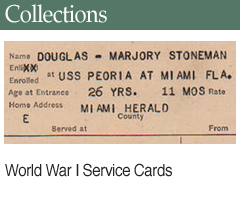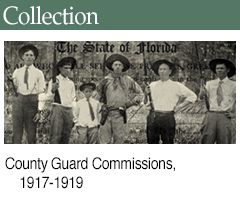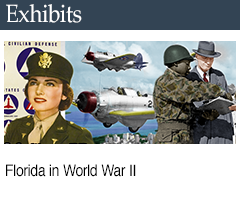Florida in World War I
Timeline: World War I in Florida
1914
- Aviator Glenn Curtiss introduces his Model J airplane, which inspires future wartime aircraft such as the Jenny. After the war, he develops the city of Opa-Locka in Dade County, which features faux-Arabian architecture.
- Due to war in Europe, Florida booms as a tourist destination for the wealthy.
- January 1: Aviator Tony Jannus piloted a Benoist airboat across Tampa Bay, marking the world's first commercial flight.
- January 17: A fire breaks out on the Jacksonville docks. Over 20 fires of varying size break out in in the city between 1914 and 1917.
- June 28: Austrian Archduke Franz Ferdinand is assassinated in Sarajevo, Bosnia and Herzegovina.
- July 28: Austria-Hungary declares war on Serbia. After several subsequent declarations of war, World War I breaks out.
- November 12: The Pensacola Naval Aeronautical Station is established. The station plays an important role in training pilots after US entry into the war.
- May 7: A torpedo sinks the British ocean liner Lusitania, which had 128 Americans aboard. Germany is blamed for the incident.
- June 19: Zena B. Dreier becomes the first women in Florida (and the South) to vote in a local election in Fellsmere.
- July 7: Thomas Edison is invited to chair the Naval Consulting Board, creating inventions in case the US enters the war. Over the next few years, Edison splits his time between Fort Myers, Key West, Long Island Sound, and elsewhere.
- November 28: The Eagle Film Company announces plans to build a studio in Jacksonville. It later becomes Norman Studios, famous for "colored" films such as The Flying Ace.
- Sidney Catts successfully campaigns for governor on the Prohibition ticket. Out-going Democratic governor Park Trammell is elected to the U.S. Senate.
- January 5: The Palm Beach Post is established. It later becomes one of Florida's major newspapers.
- July 11: In the wake of public debate over the Dixie Highway, President Woodrow Wilson signs the Bankhead Act. This is the beginning of the U.S. highway system we know today.
- August 19: The African-American "Newberry Six" are lynched by a mob just outside Gainesville. Five victims are hanged, while one is shot.
- November 7: Woodrow Wilson is re-elected president, narrowly defeating Republican challenger Charles Hughes.
- Governor Sidney Catts incites bigotry by asserting that St. Leo Abbey's "German" Catholic monks are arming African-Americans to side with Germany. This is one of multiple instances of bigotry during World War I.
- January: NAACP field secretary James Weldon Johnson visits the South to organize chapters, including Tampa and Jacksonville in his home state. He is also known for his poetry and for the spiritual "Lift Every Voice and Sing."
- February 1: Germany resumes unrestricted submarine warfare against neutral ships, including U.S. ships.
- February 2-6: A major freeze occurs, the most serious between 1899 and 1934. It kills citrus trees and compels the Seminole Indians to spend winters further south at Coppinger's Tropical Gardens.
- March 1: The media reveals the existence of the Zimmerman Telegram to the American public. Germany sent this telegram to Mexico, offering its lost American territories in exchange for Mexico's allegiance.
- April 6: The United States enters World War I against Germany. See Floridians who served with Florida Memory's World War I Service Cards.
- April 8: Marjory Stoneman Douglas is the first Miami woman to enlist in the Naval Reserve. She later serves in the Red Cross in France.
- May 21: Governor Sidney Catts signs an act (Chapter 7292) authorizing each Florida county to establish its own County Guard units. The County Guards are authorized by the Legislature in 1917 to replace the Florida National Guard, which has been called up for service in the regular United States military.
- October 15: Army Camp Joseph E. Johnston is commissioned near Jacksonville, operating until May 16, 1919.
- December 28: President Woodrow Wilson nationalizes the nation's railroads, placing them under control of the United States Railroad Administration.
- September 24: Eddie Rickenbacker becomes commander of 94th Aero Pursuit Squadron in Europe, shooting down 26 German aircraft. He later founds Florida Airways, a Florida-based Southeastern airline.
- September 26: The USS Tampa sinks in Bristol Channel, UK. Its crew includes 23 sailors from Tampa.
- October 5-November 5: An influenza ("Spanish flu") epidemic breaks out across Florida. There were 1,332 reported deaths from influenza and pneumonia combined during this time.
- November 5: Florida voters approve Amendment 2 to the state constitution, which legalizes Prohibition within Florida. Two months later, the 18th Amendment to the U.S. Constitution is enacted, legalizing Prohibition nationwide.
- November 11: The Armistice to end the war is signed in Compiègne, France.

 Listen: The FolkFolk Program
Listen: The FolkFolk Program


